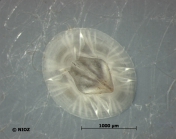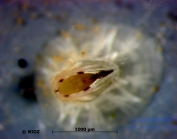
| Intro | | Search taxa | | Browse taxa | | Distributions | | Terminology | | References | | Statistics | | Online sources | | Tutorial | | Log in |
BlackSea taxon detailsAmphibalanus improvisus (Darwin, 1854)
421139 (urn:lsid:marinespecies.org:taxname:421139)
accepted
Species
Balanus improvisus Darwin, 1854 · unaccepted
marine
(of Balanus improvisus Darwin, 1854) Darwin, C. (1854). A Monograph on the Sub-Class Cirripedia with Figures of All the Species. The Balanidae, (or Sessile Cirripedia); the Verricidae, etc., etc., etc. <em>The Ray Society, London.</em> i-viii + 1-684, pls. 1-30., available online at https://ia600409.us.archive.org/30/items/monographonsubcl02darw/monographonsubcl02darw.pdf
page(s): 250 [details]
BlackSea (2021). Amphibalanus improvisus (Darwin, 1854). Accessed at: http://www.vliz.be/projects/Ocean-Ukraine/aphia.php?p=taxdetails&id=421139 on 2025-04-03
Sergeyeva, O. (2025). Black Sea checklist for Ocean-Ukraine & Sibema. Amphibalanus improvisus (Darwin, 1854). Accessed at: https://www.vliz.be/projects/Ocean-Ukraine/aphia.php?p=taxdetails&id=421139 on 2025-04-03
original description
(of Balanus improvisus Darwin, 1854) Darwin, C. (1854). A Monograph on the Sub-Class Cirripedia with Figures of All the Species. The Balanidae, (or Sessile Cirripedia); the Verricidae, etc., etc., etc. <em>The Ray Society, London.</em> i-viii + 1-684, pls. 1-30., available online at https://ia600409.us.archive.org/30/items/monographonsubcl02darw/monographonsubcl02darw.pdf
page(s): 250 [details] context source (Introduced species) Katsanevakis, S.; Bogucarskis, K.; Gatto, F.; Vandekerkhove, J.; Deriu, I.; Cardoso A.S. (2012). Building the European Alien Species Information Network (EASIN): a novel approach for the exploration of distributed alien species data. <em>BioInvasions Records.</em> 1: 235-245., available online at http://easin.jrc.ec.europa.eu [details] Available for editors context source (Deepsea) Intergovernmental Oceanographic Commission (IOC) of UNESCO. The Ocean Biogeographic Information System (OBIS), available online at http://www.iobis.org/ [details] basis of record Gittings, S. R. 2009. Cirripedia (Crustacea) of the Gulf of Mexico, Pp. 827–836 in Felder, D.L. and D.K. Camp (eds.), Gulf of Mexico–Origins, Waters, and Biota. Biodiversity. Texas A&M Press, College Station, Texas. [details] additional source Liu, J.Y. [Ruiyu] (ed.). (2008). Checklist of marine biota of China seas. <em>China Science Press.</em> 1267 pp. (look up in IMIS) [details] Available for editors additional source Lutaenko, K.A.; Furota, T.; Nakayama; S.; Shin, K.; Xu, J. (2013). Atlas of Marine Invasive Species in the NOWPAP Region. Beijing: NOWPAP DINRAC (Northwest Pacific Action Plan, Data and Information Network Regional Center). 189 pp. [details]  Present Present  Inaccurate Inaccurate  Introduced: alien Introduced: alien  Containing type locality Containing type locality
European Network on Invasive Alien Species (NOBANIS) - Balanus improvisus (from synonym Balanus improvisus Darwin, 1854)
PlanktonNet Image (from synonym Balanus improvisus Darwin, 1854) To Barcode of Life (3 barcodes) (from synonym Balanus improvisus Darwin, 1854) To Barcode of Life (49 barcodes) To Biodiversity Heritage Library (1 publication) To Biodiversity Heritage Library (150 publications) (from synonym Balanus improvisus Darwin, 1854) To Biological Information System for Marine Life (BISMaL) (from synonym Balanus improvisus Darwin, 1854) To Biological Information System for Marine Life (BISMaL) To European Nucleotide Archive, ENA (Amphibalanus improvisus) To GenBank (145 nucleotides; 120 proteins) To GenBank (145 nucleotides; 120 proteins) (from synonym Balanus improvisus Darwin, 1854) To Global Biotic Interactions (GloBI) To Information system on Aquatic Non-Indigenous and Cryptogenic Species (AquaNIS) To Niet-inheemse soorten Belgisch deel Noordzee en aanpalende estuaria (in Dutch) To PESI To PESI (from synonym Balanus improvisus Darwin, 1854) To USNM Invertebrate Zoology Arthropoda Collection (104 records) (from synonym Balanus improvisus Darwin, 1854) To USNM Invertebrate Zoology Arthropoda Collection (7 records) To Yale Peabody Museum of Natural History (YPM IZ 073648) |




